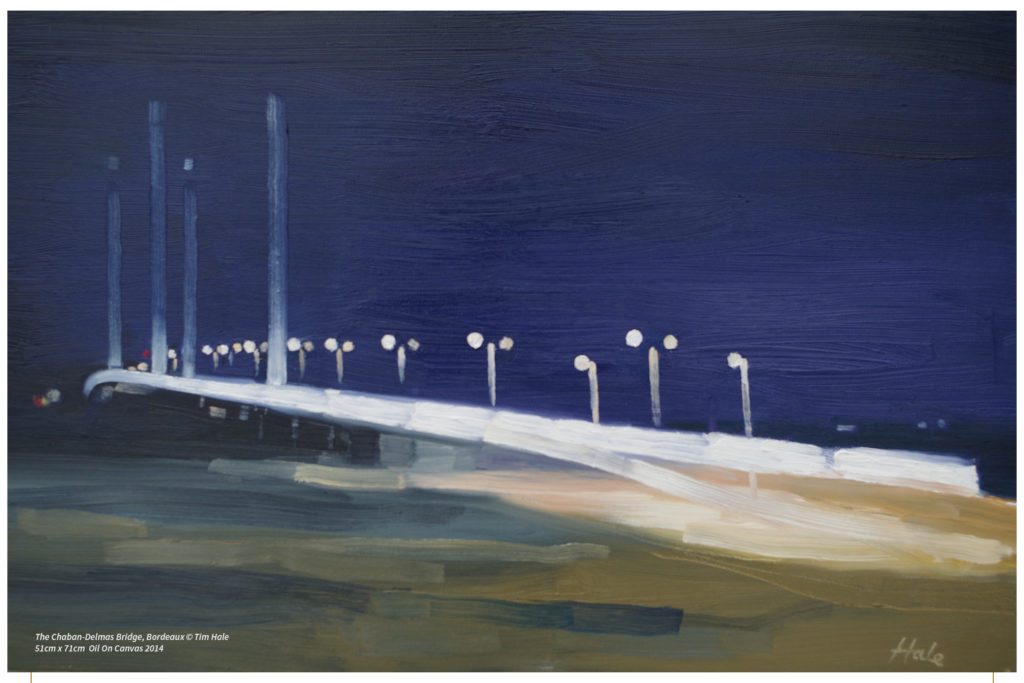Being An Artist Today
By Tim Hale

The Bouquet © Tim HALE. Acrylic on Canvas. 55x75cm. 2015
One day a young art student managed to visit Francis Bacon’s studio in London. Sadly, Bacon was not there, but it allowed the young artist to see close-up how and where the great man worked. This was the studio of one of the most famous painters of his generation, but, to an outsider, it looked like he lived in plain squalor. Paints, brushes and dirty rags were everywhere. The place was a mess and it looked like Bacon did not even work with a palette, he mixed his paints on the face of a door. The young man was Tim Hale and he realized there and then that here was Bacon’s universe and in that universe was his studio. He understood that an artist has to be totally focused and, seeing this studio, Bacon was focused.

The Chaban-Delmas Bridge, Bordeaux © Tim Hale 51cm x 71cm Oil On Canvas 2014
Being an artist can be a solitary process too. He can find himself spending days, even weeks working away on his own and then at his private view welcoming hundreds of guests. This was the case with a show Hale had last year. He spent over a year preparing an exhibition with a photographer on the theme of redevelopment in the oldest industrial area of Bordeaux and they decided to stage it in a huge warehouse on site. Thanks to networking, social media and advertising, the private view attracted over 250 people and sales were excellent. Over 80% of sales are often made during private views so it was important to invite the maximum number of people to the opening.

So gallery previews can be great fun and there is nothing better than meeting people and talking about art. However, some art galleries can be terribly cold and aloof and now many artists have found a side door to show their art. In today’s world Internet has become an essential tool for any artist. It enables them to show their work on gallery sites, advertise exhibitions and even sell online. There are now literally hundreds of ‘online galleries’ which are online platforms promoting artists’ works in return for a commission. It is fast becoming a thriving business with a global trade value of over $2.64bn and is likely to be double that by 2018. It represents nearly 5% of the estimated $55.2bn value of the global art market. Investment return is a growing motivation for online buyers, with as many as 63%, driven to purchase by a piece’s potential return on investment. The side door of online art is rapidly becoming the front door.
Tim Hale works with some online galleries too including Emillions Art in America, who exhibit over 40 artists and between 500 and 600 paintings, Kings Wood Art who sell original paintings and also reproduction prints of artists’ pictures for interior design companies or private houses, the Saatchi Art gallery which is probably the leading online gallery offering original art by emerging artists from over 100 countries and most recently MOAG or My Own Art Gallery that hosts artists’ works on the walls of a 3D virtual art gallery.
More and more experienced art collectors are increasingly using websites of this kind to buy original contemporary artwork at relatively low prices. The French company Talents d’Origine collaborates with talented contemporary artists on various interior design projects. Newcomers too are buying online. Before, new art was seen uniquely at charity auctions or elite galleries and if you were not invited you would never see it. This ‘democratization’ of modern art is seen by many professionals as a good thing. It has not only opened up the art scene but has also in many ways justified the presence of physical art galleries. People still like to discuss purchase face to face too.
Another channel is through art fairs which are also becoming increasingly popular. Art fairs are basically trade shows where curators, galleries and independent artists can meet around art displayed on hired wall space. Unfortunately, that wall space does not come cheap. Galleries, with their stable of artists, have to be there and budget accordingly, but individual artists, often under the auspices of an agent, rent a few square meters of space for sometimes hundreds or thousands of dollars, depending on the prestige of the event. So frustrations can arise when individual artists literally pay huge amounts just to be seen often shutting out many other talented artists who are not on a gallery payroll or who can never afford to exhibit. Anyway, this is a choice for artists to invest in or not. The risks are high but it is an excellent way of gaining exposure.
The 80/20 Rule, whereby an artist works around 80% of his time administering and promoting his art and 20% actually creating it is becoming more the norm and, whether we like it or not, we all live in a digital world and so long as artists are using most of their time marketing and selling their works their chances of success are far greater. Whatever the method, artists must be socially determined, create exposure and stay visible in the various marketplaces. Obviously, having confidence is important too, or rather a self-belief and conviction in what they are doing. It is not always easy, so artists have to embrace their failures and use those as steps to becoming successful. As they say, if you do not try you will never know.
Read the full article on Art Market Magazine Issue 24

